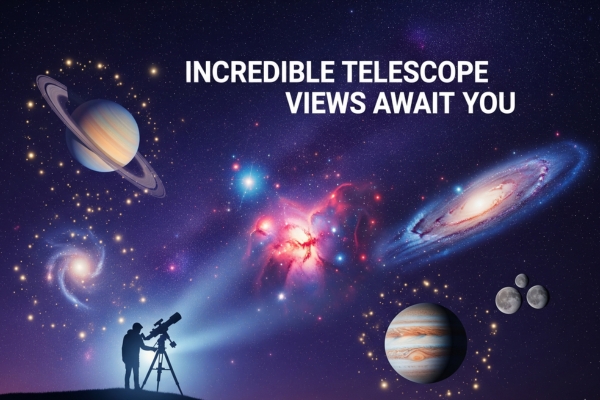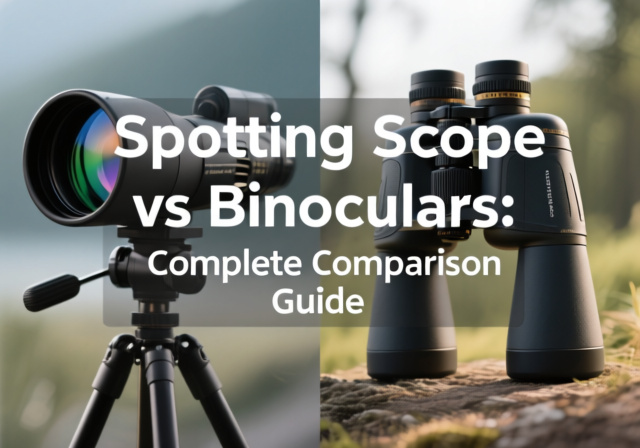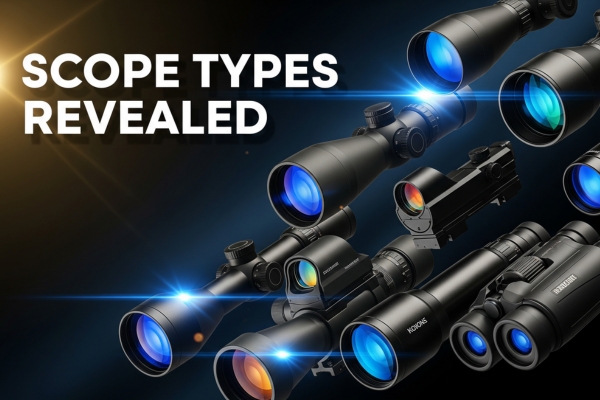



When I first pointed a telescope at the night sky, I expected to see swirling galaxies in brilliant colors, just like the NASA images I’d seen online. Reality hit quickly – but what I discovered was actually more exciting than those processed photos. Understanding what you can realistically see with a telescope transforms disappointment into genuine wonder.
After years of observing and helping beginners at star parties, I’ve learned that telescope viewing is about experiencing the cosmos firsthand, not recreating Hubble images. Let me walk you through exactly what awaits you when you peer through that eyepiece, from the craters on the Moon to distant galaxies millions of light-years away.
The key to enjoying telescope astronomy is setting realistic expectations while appreciating the profound experience of seeing these objects with your own eyes. That fuzzy blob might not look like much, but when you realize it’s a galaxy containing billions of stars, the perspective shift is breathtaking.
The Moon delivers instant gratification for telescope users. Even a modest 60mm refractor reveals stunning detail that exceeds what most beginners expect. I still remember my first telescopic view of the lunar terminator – that line between light and dark where shadows create dramatic three-dimensional landscapes.
Through a small telescope (60-80mm aperture), you’ll see hundreds of craters ranging from massive impact basins to tiny pockmarks. The lunar maria, those dark “seas” visible to the naked eye, reveal themselves as vast lava plains with subtle texture variations. Mountain ranges cast shadows miles long, and you can track their changing appearance throughout the lunar month.
With a medium telescope (100-150mm), individual crater rays become visible – those bright streaks radiating from fresh impacts like Tycho and Copernicus. You’ll spot rilles (ancient lava channels), domes (volcanic features), and the fascinating Straight Wall – a 68-mile long cliff face that appears as a dark line during certain lighting conditions.
The Moon changes dramatically based on its phase. Many beginners assume the full Moon offers the best views, but experienced observers know better. The best time is around first or last quarter when shadows along the terminator create maximum contrast. During these phases, crater walls and mountain peaks catch the sunlight while their bases remain in darkness, creating spectacular relief.
Jupiter consistently delivers impressive views through any telescope. Even a 60mm refractor shows the planet as a distinct disk with two dark equatorial belts crossing its face. The four Galilean moons – Io, Europa, Ganymede, and Callisto – appear as bright stars that change position nightly, sometimes transiting across Jupiter’s face or disappearing behind it.
With a 100mm telescope and steady air, you’ll start seeing more atmospheric detail. The Great Red Spot becomes visible when it faces Earth (check online calculators for viewing times). Additional cloud belts emerge, and you might catch the shadows of moons crossing Jupiter’s surface during transits. These shadow transits happen frequently and create some of the most exciting planetary observations available to amateurs.
Saturn never fails to amaze first-time telescope viewers. I’ve shown Saturn to hundreds of people, and the reaction is always the same: “I can actually see the rings!” Even a 50mm telescope reveals Saturn’s rings, though they appear as “ears” attached to the planet. A 70mm instrument clearly separates the rings from the planet’s disk.
Through a 100-150mm telescope, the Cassini Division – the dark gap between the A and B rings – becomes visible under good conditions. Saturn’s largest moon, Titan, appears as an orange-tinted star nearby. With careful observation, you might spot several other moons including Rhea, Dione, and Tethys.
Mars challenges telescope users more than Jupiter or Saturn. Its appearance varies dramatically based on its distance from Earth. During opposition (when Mars is closest), a 100mm telescope reveals the polar ice caps and major dark surface features like Syrtis Major. The planet’s distinct reddish-orange color is obvious even in small instruments.
Outside of opposition, Mars shrinks to a tiny disk showing minimal detail. This is why Mars observers eagerly await the biennial oppositions when the planet swells to its maximum apparent size. During the best oppositions, experienced observers with 150mm+ telescopes can detect dust storms, clouds, and subtle surface markings.
Venus appears brilliantly white and shows phases like the Moon. Through a telescope, you’ll see it change from a thin crescent when nearest Earth to a small, nearly full disk when on the far side of the Sun. However, Venus’s thick atmosphere prevents any surface detail from being visible. The best observations come during twilight when the planet’s brightness is reduced.
Mercury proves elusive, always staying close to the Sun. When visible, it shows phases similar to Venus but appears much smaller. Observing Mercury requires catching it during its greatest elongations from the Sun, either in morning or evening twilight.
Open star clusters provide some of the most satisfying views for beginners. The Pleiades (M45) transforms from a fuzzy naked-eye patch into dozens of brilliant blue-white stars surrounded by wisps of nebulosity (visible in larger telescopes under dark skies). Through a 100mm telescope, you’ll count over 100 individual stars.
The Double Cluster in Perseus offers a spectacular sight – two rich star clusters side by side in the same low-power field of view. Each cluster contains hundreds of stars, creating a three-dimensional effect that photographs can’t capture. The Beehive Cluster (M44) in Cancer spreads across more than a degree of sky, requiring low magnification to appreciate its full extent.
Globular clusters appear as fuzzy balls in small telescopes but begin resolving into individual stars with 150mm+ apertures. M13, the Great Hercules Cluster, contains hundreds of thousands of stars packed into a sphere. Through a 200mm telescope under dark skies, the outer regions resolve into countless pinpoints while the core remains a blazing mass of combined starlight.
The Orion Nebula (M42) stands out as the brightest nebula visible from the Northern Hemisphere. Even binoculars show its fuzzy glow surrounding the Trapezium – four hot young stars illuminating the surrounding gas. A 100mm telescope reveals the nebula’s distinctive butterfly shape with wispy extensions. Larger apertures and dark skies bring out subtle green and pink tints, though most nebulae appear gray to the eye.
Planetary nebulae, despite their name, have nothing to do with planets. These shells of gas expelled by dying stars often show color better than other deep-sky objects. The Ring Nebula (M57) appears as a tiny smoke ring through a 100mm telescope. The Dumbbell Nebula (M27) shows its distinctive hourglass shape, while the Cat’s Eye Nebula reveals multiple shells in larger instruments.
Emission nebulae like the Lagoon (M8) and Trifid (M20) require dark skies for the best views. Light pollution filters can dramatically improve nebula visibility from suburban locations. These filters block artificial light while transmitting the specific wavelengths emitted by nebulae.
Galaxies present the ultimate challenge for telescope observers. Unlike the colorful images from space telescopes, visual observations reveal galaxies as gray fuzzy patches. Yet knowing you’re seeing light that traveled millions of years to reach your eye creates a profound connection to the cosmos.
The Andromeda Galaxy (M31) spans several degrees of sky – too large for most telescope fields of view. Through a 100mm telescope from dark skies, you’ll see its bright central bulge and hints of the spiral arms. Its companion galaxies, M32 and M110, appear as smaller fuzzy spots nearby.
The Whirlpool Galaxy (M51) starts showing spiral structure in 150mm telescopes under excellent conditions. The face-on spiral M101 requires patience and dark skies but rewards observers with glimpses of its pinwheel shape. Edge-on galaxies like NGC 4565 appear as thin silver needles crossing the field of view.
From dark sites, a 200mm telescope can reveal dozens of galaxies in the Virgo Cluster. Spring evenings offer the best galaxy hunting, when the Virgo and Coma clusters rise high overhead. Galaxy observing teaches patience and develops observing skills as you learn to detect faint fuzzy patches at the limit of visibility.
Telescopes aren’t limited to nighttime use. The Sun offers dynamic viewing opportunities, but WARNING: Never look at the Sun through a telescope without proper solar filters. Instant and permanent blindness can result. Only use filters specifically designed for solar observation that fit securely over the telescope’s objective lens.
With proper solar filters, you’ll see sunspots – dark regions where magnetic fields suppress convection. These spots change daily, with some growing larger than Earth. During solar maximum (peaking in 2025), dozens of spots may be visible simultaneously. Solar granulation – the convection cells covering the Sun’s surface – becomes visible in good seeing conditions.
Specialized hydrogen-alpha solar telescopes reveal prominences – enormous jets of plasma extending from the Sun’s edge. These dedicated solar scopes show the chromosphere’s dynamic nature with constantly changing features. Solar flares, filaments, and spicules create an ever-changing vista completely different from nighttime observing.
Aperture (the diameter of the main lens or mirror) determines how much light your telescope collects and the finest details it can resolve. Larger apertures reveal fainter objects and finer details, but even small telescopes show impressive sights. A 70mm refractor provides years of observing enjoyment, while a 200mm reflector opens up the deep sky.
The relationship between aperture and visibility isn’t linear. Doubling the aperture quadruples the light-gathering power but only doubles the resolution. This means upgrading from a 100mm to 200mm telescope dramatically improves deep-sky views while providing more modest gains for planetary detail.
Light pollution drastically affects what you can see, particularly for nebulae and galaxies. From city centers, you might see only the Moon, planets, and brightest stars. Suburban skies allow observation of brighter star clusters and double stars. Dark rural sites reveal the Milky Way and make hundreds of deep-sky objects accessible.
Don’t let light pollution discourage you. The Moon and planets shine through even severe light pollution. Double stars, many star clusters, and some planetary nebulae remain visible from suburbs. Light pollution filters can help with certain emission nebulae. Many urban astronomers focus on objects less affected by light pollution while planning occasional trips to dark sites.
Earth’s atmosphere constantly moves, causing stars to twinkle and planetary images to blur. Astronomers call atmospheric steadiness “seeing.” Poor seeing makes planets look like boiling water, while excellent seeing reveals fine details. Seeing varies by location, season, time of night, and weather patterns.
The best seeing often occurs during temperature inversions, after cold fronts pass, or when high pressure dominates. Planets show the most detail when highest in the sky, passing through less atmosphere. Patient observers wait for moments of steady air when fine details snap into focus – these fleeting seconds reveal what your telescope can truly achieve.
Astrophotographs result from long exposures that accumulate far more light than your eye can perceive in real-time. Cameras also capture colors our eyes can’t detect in dim light. When you look through a telescope, you’re seeing ancient photons interacting with your retina in real-time – a direct connection to the cosmos that no photograph can replicate.
Visual observation develops patience and observational skills. You’ll learn to use averted vision (looking slightly to the side) to detect faint objects using your eye’s more sensitive rod cells. Over time, you’ll see details invisible to beginners as your brain learns to process the subtle information your eye collects.
The experience transcends the visual appearance. When you observe Saturn, you’re seeing light that left the planet over an hour ago. That faint smudge of the Andromeda Galaxy? Those photons traveled 2.5 million years to reach your eye. You’re literally looking back in time, experiencing the universe directly rather than through an electronic screen.
Start with easy targets to build confidence and skills. The Moon provides instant success and never gets boring as shadows shift nightly. Learn the major lunar features – it’s satisfying to recognize and name craters like old friends. Track Jupiter’s moons using online predictions, watching them dance around the giant planet.
Progress to bright star clusters like the Pleiades and Double Cluster. These forgiving targets look impressive even in light pollution. Learn the constellations to find objects more easily. Star-hopping from bright stars to fainter targets develops essential navigation skills better than computerized mounts for beginners.
Join a local astronomy club if possible. Experienced observers share knowledge generously, and club star parties provide access to various telescopes. You’ll learn more in one evening with skilled observers than months of solo trial and error. Many clubs offer loaner telescopes, letting you try different types before purchasing.
Keep an observing log to track your progress. Note the date, time, weather conditions, and what you observed. Sketching what you see, however crudely, trains your eye to notice details. Over time, your log becomes a personal record of your journey through the cosmos.
No telescope on Earth can see the Apollo landing sites in detail. The flags are far too small – you’d need a telescope with a mirror several hundred meters across. The Lunar Reconnaissance Orbiter has photographed the landing sites from lunar orbit, showing the descent stages and astronaut paths, but Earth-based telescopes lack the resolution.
The most distant object visible in amateur telescopes is the quasar 3C 273 in Virgo, about 2.4 billion light-years away. However, it appears as just a faint star-like point. For extended objects, the Andromeda Galaxy at 2.5 million light-years is easily visible, while some experienced observers with large telescopes can glimpse galaxies over 100 million light-years distant.
Planets are much smaller in angular size than most people expect. Jupiter, the largest planet, appears only 50 arcseconds across at its biggest – about 1/36 the Moon’s diameter. Mars ranges from 4 to 25 arcseconds depending on its distance. High magnification (150-250x) is needed to see planetary detail, but atmospheric turbulence often limits useful magnification.
Saturn’s rings become visible at just 25x magnification, appearing as extensions from the planet. At 50x, they clearly separate from the ball of the planet. For a satisfying view showing the Cassini Division, aim for 150-200x magnification, though this depends on your telescope’s aperture and atmospheric conditions.
Our eyes use two types of light receptors: cones for color vision in bright light and rods for dim light detection. In the dark conditions needed for deep-sky observing, only our rods function effectively, and they don’t detect color. Only the brightest nebulae show hints of color (usually green or blue-green) through large telescopes under perfect conditions.
A 6-8 inch Dobsonian reflector offers the best value for deep-sky observing, providing enough aperture to see galaxies and nebulae while remaining portable and affordable. For primarily lunar and planetary viewing, a 4-5 inch refractor or a 6-8 inch Schmidt-Cassegrain provides excellent images with more portability. Budget constraints might dictate starting with a quality 70-100mm refractor, which still shows hundreds of objects.
Yes, but tracking them is challenging since they move quickly across the sky. The International Space Station appears as a bright moving star to the naked eye. Through a telescope at low power, you might glimpse its solar panels if you can track it manually. Many observers prefer binoculars for satellite watching due to their wider field of view.
Sky darkness requirements vary by target. The Moon and planets shine through severe light pollution. Bright star clusters remain visible from suburbs. Nebulae and galaxies require progressively darker skies, with the faintest objects needing truly dark rural sites. The Bortle Scale rates sky darkness from 1 (excellent dark sky) to 9 (inner city sky), helping set appropriate expectations for your location.
Telescope observing rewards patience with profound experiences. That first view of Saturn’s rings, the moment you resolve a globular cluster into stars, or successfully finding a faint galaxy by star-hopping – these achievements create lasting memories. The universe reveals itself gradually to patient observers who return night after night.
Don’t wait for perfect equipment or ideal conditions to begin. Start with what you have, even if it’s just binoculars or a small telescope. The Moon awaits every clear night, planets parade across the sky in their seasons, and thousands of deep-sky objects hide among the stars. Each observing session builds skills and deepens your connection to the cosmos.
Remember that every professional astronomer started exactly where you are now – looking up in wonder, curious about what lies beyond. Many of astronomy’s greatest discoveries came from patient amateurs who took time to truly observe rather than simply look. Your telescope, regardless of size, is a time machine and spaceship rolled into one, ready to transport you across the universe from your backyard.
For additional photography guides and tips on capturing what you observe through your telescope, explore astrophotography techniques that can complement your visual observations. The journey from visual observer to imager is a natural progression many amateur astronomers make, combining the immediacy of visual observation with the satisfaction of capturing and sharing cosmic wonders.







